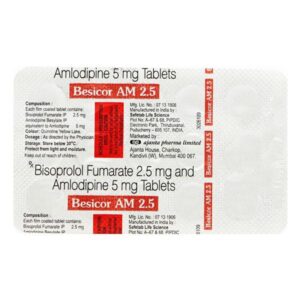BISOPROLOL + CILNIDIPINE
Bisoprolol: Bisoprolol is a medication that belongs to the class of drugs known as beta-blockers. It is commonly prescribed to treat hypertension (high blood pressure), heart failure, and to prevent future heart attacks in individuals who have had a previous heart attack.
The mechanism of action of bisoprolol involves blocking the action of certain chemicals in the body, such as adrenaline, on the heart and blood vessels. By doing so, it helps to lower blood pressure, reduce the heart rate, and decrease the workload on the heart. This ultimately helps to improve the efficiency of the heart’s pumping action and reduce strain on the cardiovascular system.
The typical starting dose of bisoprolol for hypertension is usually 5 mg once daily, which can be increased to 10 mg once daily if needed. For heart failure, the starting dose is usually 1.25 mg once daily, gradually increasing to 10 mg once daily over several weeks. Doctors may adjust the dose based on the individual’s response and tolerance.
Common side effects of bisoprolol may include dizziness, fatigue, headache, slowed heart rate, low blood pressure, shortness of breath, and gastrointestinal disturbances such as nausea and diarrhea. It is important to note that not everyone will experience these side effects, and they may vary in severity from person to person.
Rare but serious side effects that may occur include heart rhythm disturbances, worsening heart failure symptoms, and allergic reactions. It is important to seek immediate medical attention if any of these serious side effects occur.
As with any medication, it is essential to follow the dosage instructions provided by the healthcare provider and to report any concerns or side effects experienced.
Cilnidipine: Cilnidipine is a calcium channel blocker drug that is primarily used to treat hypertension (high blood pressure).
Mechanism of action:
It binds to calcium channels in the smooth muscle cells of blood vessels, blocking calcium influx. This reduces the contractility of the blood vessels, leading to vasodilation and a decrease in peripheral vascular resistance. Cilnidipine also shows selectivity for blocking the N-type calcium channels, which are primarily found in the sympathetic nerve terminals, reducing the release of norepinephrine. This dual action helps in better blood pressure control.
Use:
Cilnidipine is indicated for the management of hypertension. It can be used as monotherapy or in combination with other antihypertensive drugs. It is most commonly prescribed for patients who do not tolerate other calcium channel blockers due to side effects.
Dosage:
The usual starting dose of cilnidipine is 5 mg once daily, which can be increased up to 20 mg once daily based on the individual patient’s response. The dose may be adjusted by the healthcare provider according to the patient’s blood pressure control and tolerability.
Side effects:
Common side effects of cilnidipine may include peripheral edema (swelling of the legs and ankles), dizziness, headache, flushing, palpitations, and increased heart rate. These side effects are usually mild and transient. Less commonly, cilnidipine may cause gastrointestinal disturbances like nausea, constipation, and abdominal pain. Rarely, allergic reactions or more serious side effects such as angina (chest pain) or abnormal liver function tests may occur.
As with any medication, it is important to consult a healthcare professional before starting cilnidipine to ensure it is appropriate for the individual’s specific circumstances and medical history. It is also crucial to follow the prescribed dosage and report any concerning side effects to the healthcare provider.


